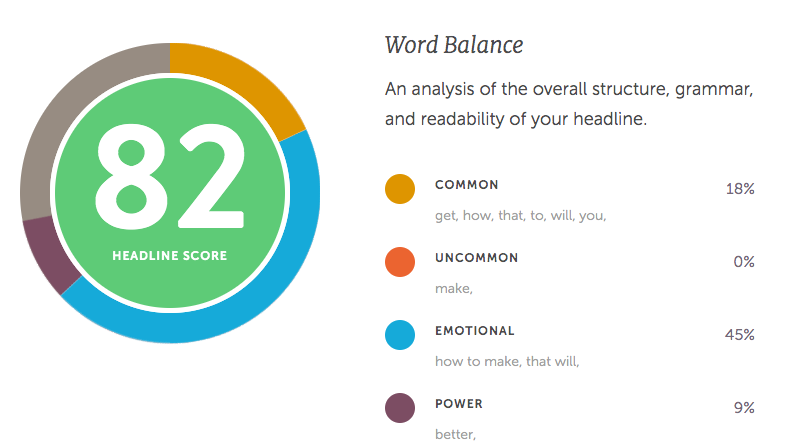You’ve just written the blog of your life; the blog that will define your writing and your career. It looks incredible on your site, the paragraphs are broken up perfectly, sentence lengths are varied, and you’re ready for the world to see your new golden child. But you’re stuck. Stuck on the last thing you need to do, but something that is just as important. You’re stuck on your headline.
I’m here to get you unstuck.
First question: Why does your beautiful blog even need a headline? Because the headline will be the deciding factor in whether or not people will actually read it. Let me rephrase that: Getting people to read your headline is not the battle; the battle is getting people to click on it. 8 out of 10 people will read your headline, but only 2 of 10 will click it. You have a 10 character long sales pitch to your potential readers, so you better make the most of it.
Check out all the episodes of our inbound marketing video series, Coffee Talks!
Types of Headlines
According to Moz there are five different kinds of headlines:
- Normal: A regular headline that tells you what the content is. News-style and standard. (ex. Nextiny Develops Smoke Signal Marketing)
- Question: Asking a question to the reader (ex. What’s the Best Coffee Cup?)
- Reader Addressing: Directly addressing your reader in your headline (ex. You Absolutely Need to Improve your Home Security)
- How to: Pretty self-explanatory, including a “How to” in your headline (ex. How to Start Your Car in a Hurricane)
- Numbers: Including a number in your headline like statistics, a ranking, or the number of topics in a blog with a list. (ex. 5 Ways to Dupe Your Dog Into Mowing the Lawn)
Make Your Headline Findable
A well-constructed headline, one that is easy to find, is optimized for SEO and interesting to the reader. In order to get that coveted 1st-page spot on Google, you must be sure to include a few things in your headline:
- Descriptive keyword phrases: Include a few keyword phrases that describe what the reader should expect in the blog, don’t mislead them. Attempt to describe as much of the who/what/when/where/why as you can without getting too wordy.
- Keyword phrases that people are searching for: Answer The Public is a useful tool to see what questions are being asked based on a keyword.
- Limit using internal company or industry jargon: Branding is important and maybe you want to add a little character to your blog title, but don’t overdo it. In order for people to find you on Google and click through to your site, create a title that makes it clear what you’re trying to convey and avoid confusing your audience with language that doesn’t make sense to them.
The Keys to a Great Headline
It’s time to construct your headline. Here are some things to make sure your headline has:
- Keep it simple: Put your thesaurus away, a headline is no time to get complicated. It should be simple and straight to the point. Don’t over-complicate it; your headline should convey what is in your blog and tell people exactly what you’re offering.
- Focus your headline on helping people: After all, the entire reason people will be searching for your keywords, and the biggest reason people search anything, is to find the answer to a question they have. Your headline needs to reassure them that you have those answers.
- Numbers work: There’s no way to be less ambiguous than to tell the reader exactly how many things they’re going to read. Having a number in your headline (ex. 10 Ways to Pet Your Dog) tells the reader exactly what they’re going to get.
- Vocab: Watch out for your word balance. You’ll need a few powerful words that grab attention and bring out emotion.
- Front-load it: People have short attention spans and most will only read the first three words in a headline, so make sure these spots are occupied by the words they’re looking for.
- Easy on the superlatives (or go hard): According to this study by Moz, over 50% of the people surveyed preferred a headline with 1 or 2 superlatives, less preferred 2 or 3, but 25% said they liked a sentence containing 4. What this tells us is go hard or not at all. Pack it full with superlatives, or only add a few.

The CoSchedule Headline Checker breaks down headlines into word types
Writing your headline
Now comes the hard part: Actually writing your headline.
The first step is to pick a headline style (question, number, etc. from above) that fits your content. If you have a list: pick a number headline. If your blog is about why something happens: pick a question headline.
Along with this, choose a tone. Tone means the emotion that you want your content to convey; happy, sad, fearful, inquisitive, etc. Your goal is to ignite an emotional response from the reader. Emotion drives us. People are more likely to click on something that insults them (Ex. You’ve Been Riding Horses Wrong Your Whole Life) rather than something purely information (Ex. The Correct Way to Ride a Horse).
You also always have the option to use a neutral headline where appropriate. Not every piece of content will be able to convey emotion like a blog about headlines or something.
Step two is the hard one: write it. Get something on the page, and something else, and another one, and so on. Write 25 or more. Get the bad ones out of the way, build on them and improve each one until you find the one you love. As you go, you can use the Headline Checker by CoSchedule to check on its viability as an SEO machine (The headline for this blog got an 82). There you can also check word balance, length, and word count.
This is the hard part and, honestly, the only part that matters. You can’t edit and improve what isn’t there.
After all this crucial information I’m sure you’re absolutely itching to start writing headlines for your blogs so I won’t stand in your way. Remember these tips and I’m sure your blogs will be flooding Google search results very soon.



-1-1.png)

